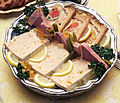Offal
Offal
Offal refers to the internal organs and entrails of a butchered animal, which are used as food. The term is often used to describe the parts of the animal that are not typically consumed in Western cuisine, although they are considered delicacies in many cultures around the world.
Etymology
The word "offal" comes from the Middle English term "offeal," which means "off fall," referring to the parts of an animal that fall off during butchering. It has been used since the 14th century to describe the edible internal parts of animals.
Types of Offal
Offal includes a wide variety of animal parts, each with its own culinary uses and nutritional benefits. Some common types of offal include:
- Liver: Rich in iron and vitamin A, liver is a popular type of offal consumed worldwide. It can be prepared in various ways, such as frying, grilling, or making pâté.
- Kidneys: Often used in dishes like steak and kidney pie, kidneys are known for their distinctive flavor and are a good source of protein and vitamin B12.
- Heart: The heart is a muscle and is often prepared similarly to other muscle meats. It is rich in iron and zinc.
- Brains: Consumed in some cultures, brains are high in omega-3 fatty acids and nutrients like vitamin B12.
- Tripe: The stomach lining of ruminant animals, tripe is used in dishes like menudo and trippa alla romana.
- Sweetbreads: These are the thymus or pancreas glands of animals, often considered a delicacy.
- Tongue: Known for its tender texture when cooked properly, tongue is used in various cuisines, including tacos de lengua in Mexican cuisine.
Cultural Significance
Offal has a significant place in many culinary traditions around the world. In some cultures, it is considered a delicacy, while in others, it is a staple food due to its affordability and nutritional value. For example, in French cuisine, dishes like foie gras and pâté de campagne are made from liver, while in Chinese cuisine, offal is used in dishes like dim sum and hot pot.
Nutritional Value
Offal is often rich in essential nutrients, including vitamins, minerals, and proteins. It is particularly high in iron, vitamin A, and vitamin B12. However, some types of offal, such as liver, can also be high in cholesterol and should be consumed in moderation.
Health Considerations
While offal is nutritious, it is important to consider the source and preparation methods. Offal can carry a risk of foodborne illnesses if not handled or cooked properly. It is also important to be aware of the potential for high cholesterol content in some types of offal.
Also see
- Portal:Food | Glossary of healthy eating | UK Foods | US Foods | Dietary Supplements | Nutrition values of foods
- Encyclopedia of nutrition | Calorie Finder | Nutrition Database | Glycemic Index of Foods | Protein rich foods list
- Lists of food & drink articles
| Meat | ||||||||||
|---|---|---|---|---|---|---|---|---|---|---|
|
Transform your life with W8MD's budget GLP-1 injections from $125.
W8MD offers a medical weight loss program to lose weight in Philadelphia. Our physician-supervised medical weight loss provides:
- Most insurances accepted or discounted self-pay rates. We will obtain insurance prior authorizations if needed.
- Generic GLP1 weight loss injections from $125 for the starting dose.
- Also offer prescription weight loss medications including Phentermine, Qsymia, Diethylpropion, Contrave etc.
NYC weight loss doctor appointments
Start your NYC weight loss journey today at our NYC medical weight loss and Philadelphia medical weight loss clinics.
- Call 718-946-5500 to lose weight in NYC or for medical weight loss in Philadelphia 215-676-2334.
- Tags:NYC medical weight loss, Philadelphia lose weight Zepbound NYC, Budget GLP1 weight loss injections, Wegovy Philadelphia, Wegovy NYC, Philadelphia medical weight loss, Brookly weight loss and Wegovy NYC
|
WikiMD's Wellness Encyclopedia |
| Let Food Be Thy Medicine Medicine Thy Food - Hippocrates |
Medical Disclaimer: WikiMD is not a substitute for professional medical advice. The information on WikiMD is provided as an information resource only, may be incorrect, outdated or misleading, and is not to be used or relied on for any diagnostic or treatment purposes. Please consult your health care provider before making any healthcare decisions or for guidance about a specific medical condition. WikiMD expressly disclaims responsibility, and shall have no liability, for any damages, loss, injury, or liability whatsoever suffered as a result of your reliance on the information contained in this site. By visiting this site you agree to the foregoing terms and conditions, which may from time to time be changed or supplemented by WikiMD. If you do not agree to the foregoing terms and conditions, you should not enter or use this site. See full disclaimer.
Credits:Most images are courtesy of Wikimedia commons, and templates, categories Wikipedia, licensed under CC BY SA or similar.
Translate this page: - East Asian
中文,
日本,
한국어,
South Asian
हिन्दी,
தமிழ்,
తెలుగు,
Urdu,
ಕನ್ನಡ,
Southeast Asian
Indonesian,
Vietnamese,
Thai,
မြန်မာဘာသာ,
বাংলা
European
español,
Deutsch,
français,
Greek,
português do Brasil,
polski,
română,
русский,
Nederlands,
norsk,
svenska,
suomi,
Italian
Middle Eastern & African
عربى,
Turkish,
Persian,
Hebrew,
Afrikaans,
isiZulu,
Kiswahili,
Other
Bulgarian,
Hungarian,
Czech,
Swedish,
മലയാളം,
मराठी,
ਪੰਜਾਬੀ,
ગુજરાતી,
Portuguese,
Ukrainian
Contributors: Kondreddy Naveen, Prab R. Tumpati, MD













